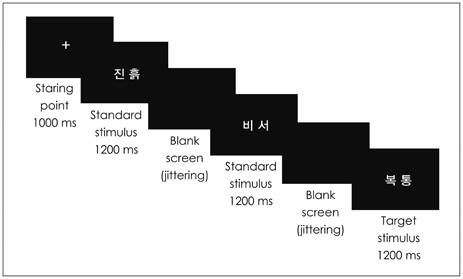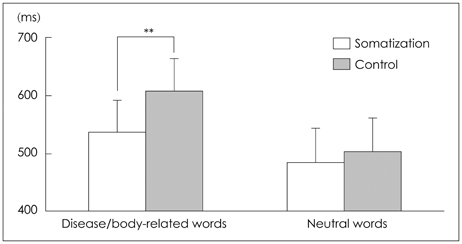J Korean Neuropsychiatr Assoc.
2014 Jul;53(4):206-213.
Automatic Attentional Bias in Individuals with Somatization Tendencies : An Event-Related Potential Study
- Affiliations
-
- 1Department of Psychiatry, Chonnam National University Hosipital, Gwangju, Korea. kybae@chonnam.ac.kr
- 2Department of Psychology, Chonnam National University, Gwangju, Korea.
- 3Department of Psychiatry, Chonnam National University Medical School, Gwangju, Korea.
Abstract
OBJECTIVES
The purpose of this study was to examine the automatic attentional bias to disease/body-related stimuli in individuals exhibiting somatization tendencies using Event-Related Potential (ERP).
METHODS
The participants were classified according to somatization and control groups based on the somatization symptom scales of the Symptom Checklist-90-Revised and Somatosensory Amplification Scale scores. ERP were recorded in the somatization and control groups while participants were performing the task to respond with neutral (standard stimuli) or disease/body-related words (target stimuli). We compared N100, P200, and P300 ERP components between the two groups.
RESULTS
In the somatization group, the reaction times to disease/body-related words were faster than for neutral words. In ERP analysis, N100 to standard stimuli was not observed in the somatization group. The somatization group showed higher P200 and P300 amplitudes to target stimuli than standard stimuli. On the contrary, in the control group, no difference in P200 and P300 amplitudes was observed between target and standard stimuli.
CONCLUSION
It is suggested that individuals exhibiting somatization tendencies have automatic attentional bias to disease/body-related stimuli and interpret disease/body-related stimuli as self-relevant stimuli.
Figure
Reference
-
1. Cioffi D. Beyond attentional strategies: cognitive-perceptual model of somatic interpretation. Psychol Bull. 1991; 109:25–41.
Article2. Kirmayer LJ, Robbins JM, Paris J. Somatoform disorders: personality and the social matrix of somatic distress. J Abnorm Psychol. 1994; 103:125–136.
Article3. Mechanic D. Social psychologic factors affecting the presentation of bodily complaints. N Engl J Med. 1972; 286:1132–1139.
Article4. Barsky AJ. Palpitations, cardiac awareness, and panic disorder. Am J Med. 1992; 92:31S–34S.
Article5. Barsky AJ, Wyshak G, Klerman GL. The somatosensory amplification scale and its relationship to hypochondriasis. J Psychiatr Res. 1990; 24:323–334.
Article6. Salkovskis PM, Clark DM. Panic disorder and hypochondriasis. Adv Behav Res Ther. 1993; 15:23–48.
Article7. Warwick HM. A cognitive-behavioural approach to hypochondriasis and health anxiety. J Psychosom Res. 1989; 33:705–711.
Article8. Warwick HM, Salkovskis PM. Hypochondriasis. Behav Res Ther. 1990; 28:105–117.
Article9. Shin HK, Won HT, Jung HY. The inference bias of illness in somatization group. Korean J Clin Psychol. 1998; 17:235–246.10. Polich J. Clinical application of the P300 event-related brain potential. Phys Med Rehabil Clin N Am. 2004; 15:133–161.
Article11. Park TJ. Observation: Neurological dissociation of implicit and explicit memory by level of processing: an event-related potential study. Korean J Cogn Biol Psychol. 2003; 15:289–301.12. Kim KI, Kim JH, Won HT. Korean Manual of Symptom Checklist-90-Revision. Seoul: ChungAng Aptitude Publishing Co.;1989.13. Won HT, Shin HK. A study on the cognitive characteristics of somatization (I): the reliability and validity of the Korean versions of Somatosensory Amplification Scale and Symptom Interpretation Questionnaire. Korean J Clin Psychol. 1998; 17:33–39.14. Seo SK. Yonsei Corpus of Lexical Frequency in Korean Vocabulary. Seoul: Institute of Language and Information Studies in Yonsei University;1998.15. Gratton G, Coles MG, Donchin E. A new method for off-line removal of ocular artifact. Electroencephalogr Clin Neurophysiol. 1983; 55:468–484.
Article16. Shin HK. A study on the cognitive characteristics of somatization (II): The perception, attribution and memory biases of bodily sensations in somatization patients. Korean J Clin Psychol. 1998; 17:41–54.17. Shin HK. The relationship of academic stress, negative affectivity, alexithymia, and perceived parenting behavior to somatization in adolescents. Korean J Clin Psychol. 2002; 21:171–187.18. Gordon E, Kraiuhin C, Kelly P, Meares R, Howson A. A neurophysiological study of somatization disorder. Compr Psychiatry. 1986; 27:295–301.
Article19. Gordon E, Kraiuhin C, Meares R, Howson A. Auditory evoked response potentials in somatization disorder. J Psychiatr Res. 1986; 20:237–248.
Article20. James L, Gordon E, Kraiuhin C, Howson A, Meares R. Augmentation of auditory evoked potentials in somatization disorder. J Psychiatr Res. 1990; 24:155–163.
Article21. Freunberger R, Klimesch W, Doppelmayr M, Höller Y. Visual P2 component is related to theta phase-locking. Neurosci Lett. 2007; 426:181–186.
Article22. Luck SJ, Hillyard SA. Electrophysiological correlates of feature analysis during visual search. Psychophysiology. 1994; 31:291–308.
Article23. Bernat E, Bunce S, Shevrin H. Event-related brain potentials differentiate positive and negative mood adjectives during both supraliminal and subliminal visual processing. Int J Psychophysiol. 2001; 42:11–34.
Article24. Näätänen R, Simpson M, Loveless NE. Stimulus deviance and evoked potentials. Biol Psychol. 1982; 14:53–98.
Article25. Hackley SA, Woldorff M, Hillyard SA. Cross-modal selective attention effects on retinal, myogenic, brainstem, and cerebral evoked potentials. Psychophysiology. 1990; 27:195–208.
Article26. Kanske P, Kotz SA. Concreteness in emotional words: ERP evidence from a hemifield study. Brain Res. 2007; 1148:138–148.
Article27. Evans KM, Federmeier KD. The memory that's right and the memory that's left: event-related potentials reveal hemispheric asymmetries in the encoding and retention of verbal information. Neuropsychologia. 2007; 45:1777–1790.
Article28. Thomas SJ, Johnstone SJ, Gonsalvez CJ. Event-related potentials during an emotional Stroop task. Int J Psychophysiol. 2007; 63:221–231.
Article29. Squires NK, Squires KC, Hillyard SA. Two varieties of long-latency positive waves evoked by unpredictable auditory stimuli in man. Electroencephalogr Clin Neurophysiol. 1975; 38:387–401.
Article30. Gray HM, Ambady N, Lowenthal WT, Deldin P. P300 as an index of attention to self-relevant stimuli. J Exp Soc Psychol. 2004; 40:216–224.
Article31. Smith ME, Halgren E, Sokolik M, Baudena P, Musolino A, Liegeois-Chauvel C, et al. The intracranial topography of the P3 event-related potential elicited during auditory oddball. Electroencephalogr Clin Neurophysiol. 1990; 76:235–248.
Article
- Full Text Links
- Actions
-
Cited
- CITED
-
- Close
- Share
- Similar articles
-
- Exploratory Study: A Modification Training Method of Attentional Bias Toward Safety
- Asymmetry of Auditory Event-Related Potential P300 in Patients with Schizophrenia
- Effects of SSRI Antidepressants on Attentional Bias toward Emotional Scenes in First-Episode Depressive Patients: Evidence from an Eye-Tracking Study
- The Neuroanatomy and Psychophysiology of Attention
- Attentional Dysfunction in Major Psychiatric Disorders




